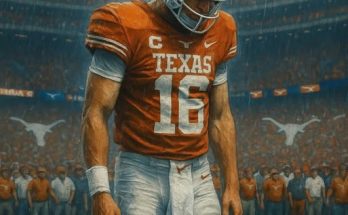Texas freshman safety Jonah Williams will not be suiting up against UTEP this week, and by all accounts, his return to the field is not expected to happen in the immediate future. Williams, who has been working through a hamstring issue since the summer, remains on the mend, and head coach Steve Sarkisian and the Texas training staff appear committed to ensuring that his recovery is handled with care and patience rather than urgency. While the news is disappointing for fans eager to see the highly regarded newcomer in action, the program’s approach highlights the balance between player health and team needs, particularly when dealing with injuries that can linger if not treated properly.
According to Anwar Richardson, who covers the Longhorns closely, Williams’ absence should not come as a surprise. “I’d be surprised if we see freshman safety Jonah Williams on the field anytime soon,” Richardson reported, underscoring that the young defender is still recovering. He added that Sarkisian is unwilling to risk Williams’ long-term health by rushing him back before he is fully ready. This type of cautious approach has become the standard in programs with the kind of depth and long-term vision Texas possesses, particularly when it involves a freshman still adjusting to the speed and demands of college football.
Hamstring injuries are notoriously tricky, especially for defensive backs who rely heavily on quick-twitch movements, acceleration, and lateral agility. For safeties, the hamstring is constantly tested — whether in sprinting to close down a receiver, turning and chasing on a deep ball, or planting to break toward the line of scrimmage. A setback can happen easily if the muscle is not completely healed, and for a player like Williams, who is still developing his body for the rigors of the college game, a cautious return is critical. It is not unusual for these types of injuries to sideline athletes for weeks or even months, particularly when the player’s future is considered more important than short-term availability.
Williams came to Texas with a reputation as a smart, physical, and versatile safety prospect, someone expected to eventually contribute in meaningful ways to a defensive secondary that has seen its share of ups and downs in recent seasons. His athleticism and instincts made him one of the more intriguing newcomers in the 2024 recruiting class, and many believed he could work his way into rotation snaps by midseason if healthy. However, injuries can derail even the most promising starts, and the program has adjusted accordingly by leaning on its veteran depth and other younger players who are ready to contribute right away.
The Longhorns’ secondary already features a mix of established starters and developing depth, giving Sarkisian some flexibility in handling Williams’ absence. While his immediate impact will be delayed, his long-term potential remains intact. For Texas, the focus remains not on rushing Williams into a game situation but on building him into the kind of player who can contribute consistently over the next three to four years. Sacrificing a few early games, or even a full season if necessary, is a small price to pay compared to risking repeated injuries that could hamper his development and career trajectory.
Coach Sarkisian has made it clear throughout his tenure at Texas that player health comes first, even when the team faces pressing needs at certain positions. This philosophy has helped the program build trust with athletes and their families, reinforcing the idea that development is as much about physical well-being as it is about playbook mastery and on-field execution. In the case of Williams, Sarkisian’s decision to wait until the freshman is completely ready emphasizes the program’s confidence in its depth while also highlighting its commitment to the long-term vision for its roster.
From a strategic standpoint, Williams’ absence against UTEP is unlikely to drastically alter the defensive game plan. Texas enters the matchup as a heavy favorite, and the Miners’ offensive attack is not expected to pose a serious threat to the Longhorns’ secondary. This affords the coaching staff the ability to give more snaps to other safeties and defensive backs, testing their depth and building experience for players who may need to step into bigger roles later in the season. If there is ever a time to be cautious with a player like Williams, it is early in the year, particularly in matchups where the Longhorns hold a clear advantage.
The broader question is when Williams might actually be expected back. Given the language used by Richardson and the staff’s cautious approach, it appears unlikely that he will return in the next couple of weeks. Hamstring injuries often come with an uncertain timeline, and every player recovers differently. Some can return within a few games, while others may require extended rest, rehabilitation, and strength training before they are cleared for action. Texas has the luxury of not needing to rush him, and while the exact timeline remains unclear, the emphasis has been on making sure that when Williams does return, he does so without fear of reinjury.
Fans may feel a sense of impatience, particularly given the hype surrounding Williams’ potential, but those familiar with college football understand the bigger picture. Freshmen often face an uphill battle in adjusting to the college game even without injuries. Adding a setback like this only underscores the importance of giving a young player time to develop at his own pace. Texas has invested heavily in its recruiting classes, and the program has built a level of depth that allows it to withstand the temporary absence of any single player. Williams’ situation, while frustrating for him personally, is not expected to derail the team’s broader ambitions for the season.
For Williams himself, this period can serve as a learning opportunity. Being sidelined provides time to study the playbook more deeply, watch film of both opponents and teammates, and work with position coaches to refine the mental side of the game. Many players who have gone through similar situations often emerge stronger and more prepared, using their time off the field to sharpen the parts of their game that are not reliant on physical reps. If Williams takes this approach, his eventual return could be even more impactful, as he combines improved mental preparation with a fully healed body.
The importance of hamstring health for athletes in skill positions cannot be overstated. Numerous examples across both college and professional football demonstrate how repeated hamstring injuries can derail promising careers. The decision to prioritize long-term recovery reflects a growing awareness across the sport that player longevity must be protected, particularly in an era where the demands on athletes are greater than ever. Between year-round training, increased game intensity, and the spotlight of expectations, players like Williams face immense pressure to return quickly. Sarkisian’s refusal to succumb to that pressure is a testament to his leadership and the program’s commitment to doing things the right way.
Looking ahead, Texas will continue to prepare for UTEP and beyond with its available personnel. Other defensive backs will have the opportunity to gain valuable reps, and the coaching staff will be able to evaluate depth options that may prove useful later in the season. For Williams, the focus will remain on daily progress, consistent rehab, and incremental improvement until he is fully cleared. It may not be the immediate debut fans envisioned, but it remains the smartest path forward.
In the grand scheme of the season, the absence of one freshman, no matter how talented, is unlikely to define Texas’ trajectory. The Longhorns are chasing lofty goals this year, including a conference championship and a potential playoff berth, and those ambitions will be fueled by the collective strength of the roster rather than the presence or absence of a single player. Williams’ role, while delayed, will eventually become a part of that picture, and the hope is that when he does step onto the field, he will be healthy, confident, and prepared to contribute at a high level.
For now, the story is one of patience and perspective. Texas fans will have to wait to see Jonah Williams in action, and Williams himself will need to stay disciplined during a frustrating period of recovery. The good news is that the program’s approach gives him every chance to heal properly, ensuring that when he does make his long-awaited debut, it will be with the best chance to succeed. Football careers are long and often filled with obstacles like this, but with the right support system, the setbacks become stepping stones rather than roadblocks.
Injuries are an unavoidable part of the game, but how they are managed often determines the long-term impact on a player’s career. In Williams’ case, the Longhorns have made the right call, focusing not on short-term fixes but on sustainable development. It may mean more waiting for fans, but the patience shown now will likely pay dividends down the line. When Jonah Williams finally does put on his Texas uniform and takes the field, the journey through this recovery will be part of the foundation for the player and leader he is destined to become.



